|
Reviews of Recent Independent, Foreign, & Documentary Films in Theaters and DVD/Home Video

DARK STREETS
Dark Streets is an ambitious effort to seduce film noir with the movie musical. Strikingly similar in look and storyline to 2006’s Idlewild, which was more upbeat and entertaining despite awkwardly trying to integrate Prohibition-era music with hip hop, here the noir is visually and thematically dark and the music a serious contribution to the blues repertory. Playboy scion Chaz Davenport (Gabriel Mann) goes into debt to loan sharks in financing his nightclub, the kind of upscale speakeasy where his sometime lover Crystal (Bijou Phillips) reigns as the lead singer and dancer—until a mysterious new chanteuse attracts the boss’s attentions, Madelaine (Izabella Miko). In addition to the doomed romantic love triangle and the typical corrupt cop (Elias Koteas), there’s a photographer who specializes in compromising photographs of politicians. On top of this, the club, as well as the city, is threatened by rolling power outages as the utility company ruthlessly seeks more profits through political control (think Enron crossed with the water-hungry magnates in Chinatown). Unfortunately, this complicated premise is set up through exaggerated 1930s period costumes, dark production design, and busy camera work that overwhelm the young bland cast. The actors seem caught between the noir experiments of the digitized Sin City and the child gangsters in Alan Parker’s Bugsy Malone. But there are sophisticated elements that rise above this murk. The singular sensation is the debut of Toledo as Prince Royale, who captures the camera in a role like Joel Grey’s master of Cabaret ceremonies, and narrates the story in a sexy growl. Described as an “underground performer” from L.A. clubs, he looks, sounds, and moves like the actor/choreographer Geoffrey Holder. The choreography by Keith Young (Rent) reinforces the period feel when director Rachel Samuels first shoots the production numbers at Busby Berkeley angles. As the city and the club are taken over by a more corrupt big spender, the dancers surround Prince in moves out of Bob Fosse’s Sweet Charity and Chicago. But these dirty alleys are not full of the usual Tin Pan Alley musical numbers. Dark Streets repeats and reinforces its tag line of “Welcome to the blues.” Though shot at night with downtown Los Angeles’ art deco architecture representing any city, the music salutes the New Orleans sound (a portion of the film’s profits goes to a blues-related charity there). With the exception of Toledo leading the sassy “Talking to the Devil,” the most resonant songs are not performed in the club. British blues fans James Compton, Tim Brown, and Tony de Meur composed original songs for the soundtrack to reflect the characters’ feelings, with lyrics like “I asked God for nothing and got it in spades.” They attracted stellar interpreters for each track— such singers as Natalie Cole, Dr. John, Etta James, Chaka Khan, and Aaron Neville, backed by the recognizable sounds of players like Richie Sambora on guitar, David Sanborn on sax, and Kenny Aronoff on drums. Ironically, the music sharpens the contrast to the pedestrian cast on the screen. (But then, Etta James’s world-weary delivery on “It Ain’t Right” also blows away Beyoncé’s portrayal of her in Cadillac Records.) But buyer beware: While neither of the songs sung at the club by the competing women is included on the soundtrack record, B.B. King’s distinctive guitar work is also unfortunately left off the disc.
There’s a long tradition of
movie songs outshining or outliving weak source material. Hopefully,
Toledo and these exciting new blues songs will rise from the noir into
the light of more public attention.
Nora Lee Mandel
|

